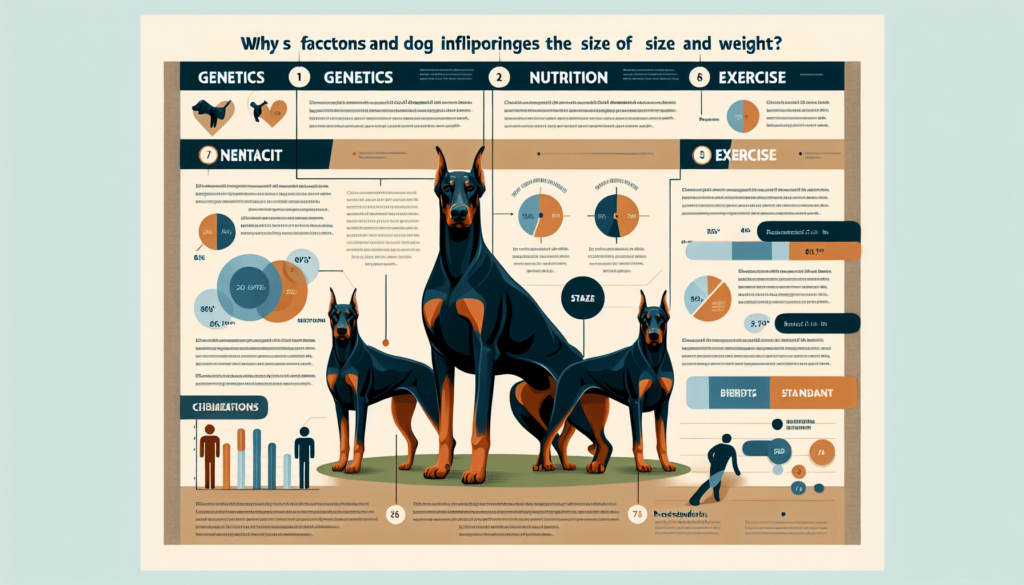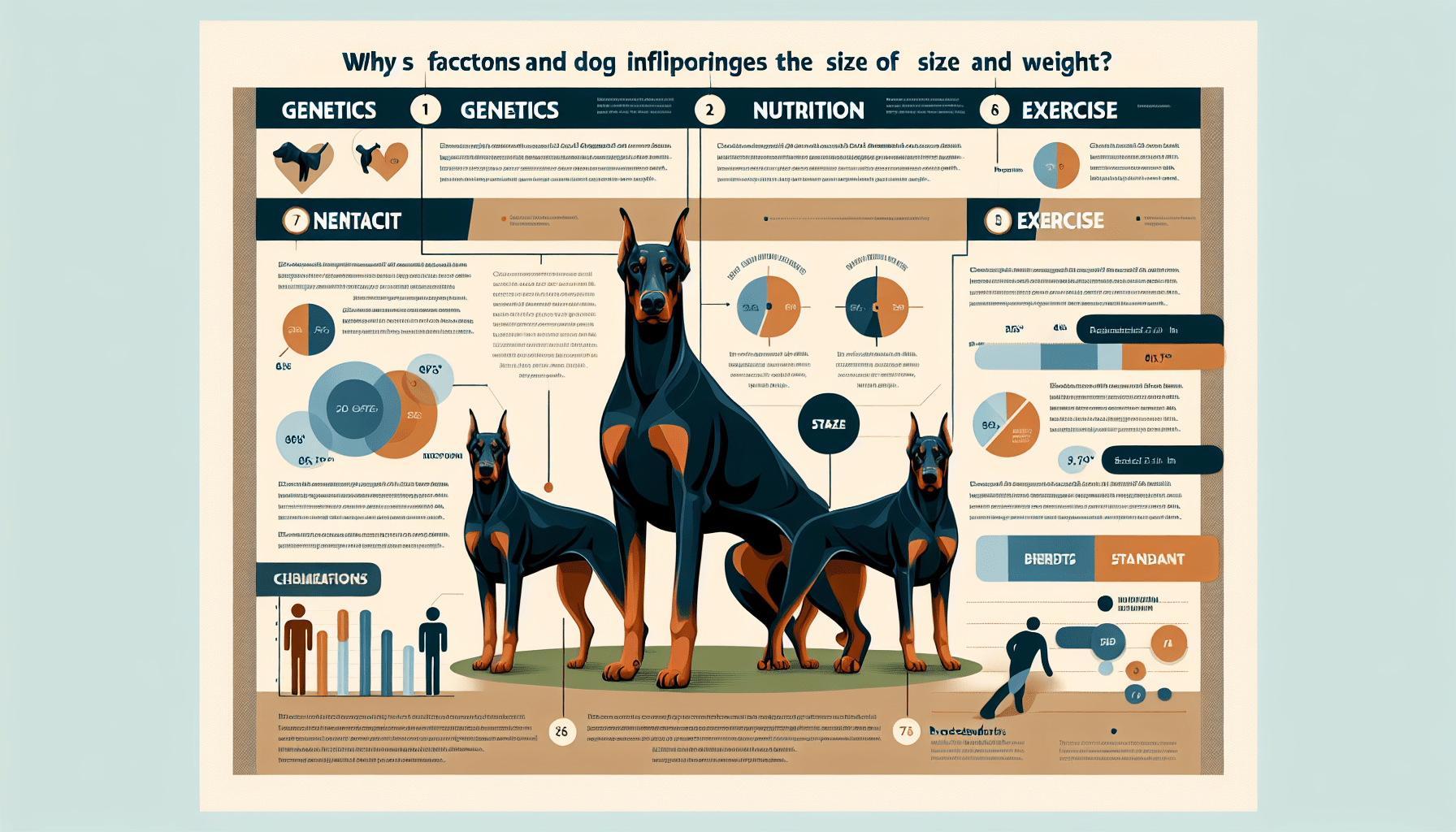If you’ve ever wondered about the size and weight of Doberman Pinschers, this article is here to help. By providing valuable insights into the dimensions of these iconic dogs, you’ll gain a better understanding of their physique and what to expect when owning one. From their average height to their weight range, this article aims to assist both current and prospective Doberman owners in comprehending the unique characteristics of this breed.
Appearance of Doberman Pinschers
Doberman Pinschers are medium to large-sized dogs that are known for their strong and sleek appearance. Their muscular build and elegant stance make them instantly recognizable. When discussing the appearance of Doberman Pinschers, it is essential to consider their height, weight, and proportions.

Height
The height of Doberman Pinschers is an important factor that contributes to their overall appearance. According to breed standards, the average height for males is between 26-28 inches (66-71 cm) at the shoulder, while females typically measure between 24-26 inches (61-66 cm). These measurements reflect the standard height for the breed, but variations can occur.
Variations in Height
Doberman Pinschers can vary in height, even within the breed standard. Some individuals may be slightly taller or shorter than the average measurements. However, it is essential to note that extreme variations from the standard height may indicate potential health issues or deviations from the breed standard.
Factors Affecting Height
Several factors can influence the height of a Doberman Pinscher. Genetics play a significant role, as certain bloodlines may tend to produce taller or shorter dogs. Additionally, proper nutrition and exercise during the puppy stages can contribute to healthy growth and reaching the dog’s potential height.
Weight
Along with height, the weight of a Doberman Pinscher also contributes to their appearance and overall physique. Maintaining an appropriate weight is crucial for the dog’s health and well-being.
Standard Weight
As per breed standards, the ideal weight for male Doberman Pinschers is between 75-100 pounds (34-45 kg), while females typically weigh between 60-90 pounds (27-41 kg). These weight ranges signify the target weight for a Doberman Pinscher and help ensure a balanced and athletic build.
Variations in Weight
While the standard weight ranges provide a guideline, individual Doberman Pinschers may vary slightly in weight. Factors such as bone structure, muscle mass, and overall body composition can influence the dog’s weight. However, it is important to monitor and maintain a healthy weight within the breed’s recommended range.
Factors Affecting Weight
Multiple factors can affect the weight of a Doberman Pinscher. Genetic predisposition can influence the dog’s natural tendency to gain or lose weight. Moreover, sex, age, nutrition, and exercise play significant roles in maintaining a healthy weight. It is crucial to provide balanced meals, monitor portion sizes, and engage in regular exercise to prevent weight-related issues.
Proportions
Doberman Pinschers have distinctive proportions that contribute to their elegant appearance. Paying attention to their length, chest, head, and neck proportions is important for a well-rounded understanding of their appearance.
Length
A Doberman Pinscher’s body exhibits a balanced proportion of length. The length, measured from shoulders to the base of the tail, should be roughly equal to the height of the dog at the shoulder. This proportion ensures a sleek and graceful appearance without appearing too elongated or compact.
Chest
The chest of a Doberman Pinscher is another important aspect of their proportions. It should be deep and broad, allowing for ample lung capacity and endurance. A well-developed chest contributes to the overall strength and athleticism of the breed.
Head
The head of a Doberman Pinscher is a characteristic feature that defines their appearance. It should be in proportion to the body, neither too large nor too small. A well-defined and balanced head enhances the breed’s regal and alert expression.
Neck
A Doberman Pinscher’s neck should be muscular and well arched, blending smoothly into the shoulders. It should neither be excessively long nor short, maintaining proper balance and contributing to the breed’s overall appearance.
Factors Affecting Size and Weight
Several factors can influence the size and weight of a Doberman Pinscher. Understanding these factors can help owners make informed decisions regarding their pet’s health and well-being.
Genetics
Genetics play a significant role in determining a Doberman Pinscher’s size and weight. Puppies inherit certain traits from their parents, including their potential height and weight range. Responsible breeders strive to produce puppies that align with the breed standard, taking into account their genetic background.
Sex
Sex also influences the size and weight of a Doberman Pinscher. Generally, males tend to be larger and heavier than females. Male Doberman Pinschers often have a more robust build, while females usually exhibit a slightly more delicate appearance.
Age
Age is another factor that affects the size and weight of Doberman Pinschers. Puppies go through various growth stages, and their size and weight can change rapidly during their first year. It is crucial to nourish them properly, monitor their growth, and provide appropriate exercise.
Nutrition and Exercise
Proper nutrition and exercise are essential for maintaining a healthy size and weight for Doberman Pinschers. A well-balanced diet rich in high-quality proteins, healthy fats, and essential nutrients supports their growth and development. Regular exercise helps them maintain muscle tone, burn excess calories, and prevent weight-related issues.

Health Implications
Maintaining a healthy size and weight is crucial for the overall well-being of a Doberman Pinscher. Both being underweight or overweight can lead to health implications that should be addressed and managed appropriately.
Underweight
Being underweight can indicate a nutritional deficiency or an underlying health condition. Doberman Pinschers that are underweight may lack energy, have poor muscle development, and exhibit a dull coat. Consultation with a veterinarian is essential to determine the cause and implement a suitable dietary plan.
Overweight
Doberman Pinschers that are overweight may experience joint problems, reduced mobility, and an increased risk of other health issues. The excess weight can strain their joints and compromise their overall agility. It is crucial to monitor their weight and adjust their diet and exercise regimen accordingly to maintain a healthy body condition.
Body Condition Score
Evaluating a Doberman Pinscher’s body condition score (BCS) can help determine if they are at a healthy weight. A BCS ranges from 1 to 9, with 1 being severely underweight and 9 being obese. A score of 4-5 is generally considered optimal, indicating an ideal balance of muscle and fat for a Doberman Pinscher.
Growth and Development
Understanding the growth and development of Doberman Pinschers is important for ensuring their proper care and well-being, especially during their puppy stages.
Puppy Growth Stages
Doberman Pinscher puppies go through several growth stages. The neonatal stage covers the first two weeks of their life, followed by the transitional stage until they reach around 4 weeks. The socialization stage occurs between 4-12 weeks, and the juvenile stage extends from 4 months to around 2 years. Each stage requires appropriate nutrition, socialization, and healthcare to support their development.
Appropriate Weight Gain
During the puppy stage, Doberman Pinscher puppies should gain weight steadily but not excessively. Rapid weight gain can put stress on their developing bones and joints. Working closely with a veterinarian to ensure proper nutrition and regular weigh-ins helps monitor their growth and adjust their diet accordingly.
Monitoring Size and Weight
Regular monitoring of a Doberman Pinscher’s size and weight is crucial, especially during their growth stages. Keeping track of their height and weight through regular measurements helps detect any deviations or potential health concerns. It is important to remember that each dog is unique, and individual growth rates can vary.
Comparison to Other Breeds
When considering the size and weight of Doberman Pinschers, it is helpful to compare them to other breeds to gain a better understanding of their proportions and athletic abilities.
Size Comparison
Doberman Pinschers fall into the medium to large-sized category. They are larger than many small and medium-sized breeds but not as large as giant breeds such as Great Danes or Mastiffs. Their size allows them to strike a balance between agility and strength.
Weight Comparison
In terms of weight, Doberman Pinschers generally weigh more than smaller breeds like Beagles or Jack Russell Terriers. However, they are lighter than larger breeds like Rottweilers or Saint Bernards. The Doberman Pinscher’s weight range contributes to their agility and swift movements.
Athletic Abilities
Doberman Pinschers are renowned for their athleticism and physical prowess. Their size and weight allow them to excel in various activities, including obedience, tracking, and agility. Their well-balanced proportions and muscular build enable them to perform tasks with grace and efficiency.
Perceptions and Expectations
Understanding the perceptions and expectations surrounding the size and weight of Doberman Pinschers helps dispel common misconceptions and provides insight into their ideal size for different roles.
Misconceptions about Size
There are several misconceptions regarding the size of Doberman Pinschers. Some individuals may believe that bigger is always better or associate a larger size with increased aggression. However, size alone does not determine temperament or behavior. Responsible breeding and proper training are more influential factors in shaping a Doberman Pinscher’s temperament.
Size vs. Temperament
The size of a Doberman Pinscher does not necessarily correspond to their temperament. While larger Doberman Pinschers may appear more formidable, their temperament is primarily influenced by genetics, socialization, and training. Well-bred and properly socialized Doberman Pinschers can be friendly, loyal, and good-natured, regardless of their size.
Ideal Size for Different Roles
Different roles may require Doberman Pinschers of varying sizes. For example, Doberman Pinschers involved in competitive obedience or agility may benefit from a more agile and compact build. Conversely, Doberman Pinschers used in protection work may benefit from a larger and more imposing appearance. Ultimately, the ideal size for a Doberman Pinscher depends on the intended purpose and individual characteristics.
Tips for Managing Size and Weight
Maintaining a Doberman Pinscher’s size and weight within the appropriate range requires proper care, attention, and adherence to specific guidelines.
Feeding Guidelines
Following feeding guidelines provided by reputable breeders or veterinarians is crucial for managing a Doberman Pinscher’s size and weight. Age, activity level, and overall health should be considered when determining portion sizes and selecting the appropriate diet. It is important to avoid overfeeding or underfeeding, as both can lead to health issues.
Exercise Recommendations
Regular exercise is essential for maintaining a healthy body weight and muscle tone in Doberman Pinschers. Engaging in activities such as daily walks, playtime, or specialized training sessions helps prevent weight gain and keep the dog physically fit. Consulting with a veterinarian can provide guidance on suitable exercise routines for individual dogs.
Veterinary Care
Regular veterinary care is vital for monitoring a Doberman Pinscher’s size, weight, and overall health. Annual check-ups, vaccinations, and preventive measures such as heartworm prevention are essential for their well-being. Veterinarians can also provide guidance on nutrition, weight management, and address any concerns related to size or weight.
In conclusion, understanding the size and weight of Doberman Pinschers is essential for their care, well-being, and overall appearance. Their height, weight, and proportions contribute to their distinctive and elegant physique. By considering genetics, sex, age, nutrition, and exercise, owners can ensure that their Doberman Pinschers maintain a healthy size and weight throughout their lives. Regular monitoring, appropriate feeding, exercise, and veterinary care are key aspects of responsible ownership. By following these guidelines, Doberman Pinschers can thrive and exhibit the optimal size and weight to fulfill various roles, while maintaining their friendly and good-natured demeanor.
